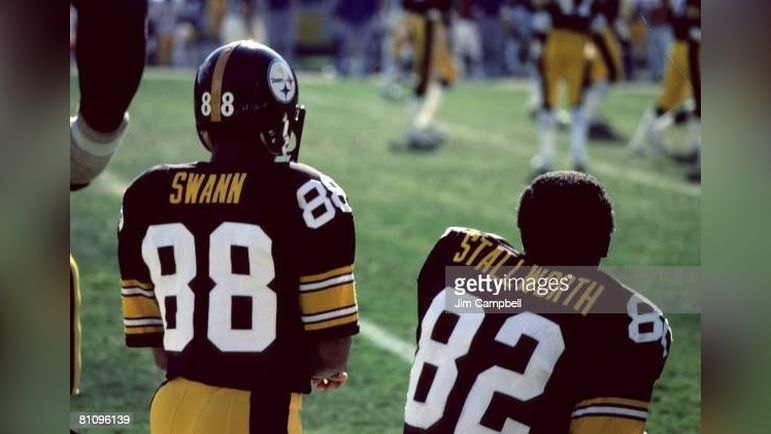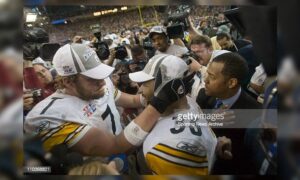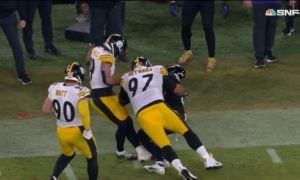Alright everyone. We are back with the final installment of the most unbreakable Steelers’ records of all time. Thanks for reading along over the past few weeks, I’ll link all the previous parts below.
Part One
Part Two
Part Three
Part Four
Before we get into it, I wanted to talk about some of the tougher omissions. The primary goal of this series was just to be a fun look at some of the best moments and achievements in Steelers’ history, not an exact scientific ranking. As a result, I tried to keep the records from overlapping too much, as there is probably a handful you could get from that legendary ‘76 defense alone.
Also, the James Harrison Super Bowl interception return was hard to leave off the list but it seemed like a Super Bowl record was too specific, and I wanted to avoid “cherry-picking’ stats. Lastly, a lot of special teams stats could have made this list due to the rule changes with the slow removal of the kickoff return and extra points being a lot harder now. For my money, an article about making 100% of your extra points seems pretty boring to me, so I avoided it. But without any more delay, let’s see number two.
Number Two: Ben Roethlisberger Winning 15-straight Games To Start His Career
Let’s go back to 2004 for a second. The greatest regular season record in Pittsburgh history at 15-1. The Steelers’ were the best defense in the league by both yards and points, their only loss coming in week two in Baltimore against the Ravens. An absolutely fantastic season by any metric, all led by a rookie quarterback.
The season didn’t begin with Roethlisberger at the helm, as the eleventh-overall pick was sitting behind veteran Tommy Maddox. But when Maddox went down with an injury, Big Ben took over the starting role and never gave it back. Behind their new signal caller, the team ripped off fourteen straight regular-season victories to turn a 1-1 start into a 15-1 finish. In weeks eight and nine, the Steelers would scoop up back-to-back wins over both teams that would end up in the Super Bowl that season, the Patriots and the Eagles. Their hot streak would earn them the one seed, and they knocked off the Herm Edwards-led Jets in the divisional round to secure their 15th straight win. The streak would end the next week against the Patriots in the AFC Championship game.
What has gotten a little lost to time is how unexpected that season was for the franchise. You look at the roster and see names like Roethlisberger, Jerome Bettis, Hines Ward, James Farrior, Troy Polamalu, and Joey Porter all performing at a high level, and it seems obvious that they would be good. But their over/under for wins going into the season was just 7.5, and they were tied with the Raiders (who would go 5-11) for the 20th-longest Super Bowl odds. They were also coming off a disappointing 6-10 season in 2003.
And that’s what makes this record so difficult to break. You have to have both a high enough draft pick to get one of the top rookie quarterbacks, while also being good enough that said quarterback can win right away. That doesn’t happen too often. As a result, a lot of the other players who are close to the record have had some unique circumstances.
Next on the list behind Roethlisberger with ten wins each are Mike Tomczak and Mike Livingston. Tomczak ended up playing with the Steelers late in his career, but he set his mark with the Chicago Bears. Tomczak was actually undrafted, and he filled in for Jim McMahon for those elite mid-80s Bears teams when McMahon was sidelined with injuries. Livingston also filled in for an injured usual starter in Chiefs legend Len Dawson and played on those solid Chiefs teams in the late 60s who picked up a Super Bowl in 1969.
Recently, the closest anyone has gotten is Jimmy Garoppolo, who picked up seven straight over multiple seasons with the Patriots and 49ers. Brock Purdy has an active streak of five, but his Tommy John surgery leaves a big question mark over this season for him.
How would someone break it?
It’s true for all of these records, but you need a lot of luck for this one. And even some bad luck, as it seems like a lot of guys who make a run at this take over mid-season when the starter gets injured. Steelers-wise, you’d like to think Kenny Pickett can be the starter for the foreseeable future, and he’s already lost a game so he has no shot at this. I guess the only thing you could say that is a positive is that the Steelers certainly have an above-average organizational infrastructure to support a new quarterback or some sort of emergency situation.
Number One: The Steelers Draft Four Hall Of Famers In 1974
In my opinion, this is far and away the best draft an NFL team has ever had. What is even more wild is that the Steelers didn’t have a single top-20 pick in this draft, as they were coming off a 10-3-1 1973 season. But that didn’t stop them from hitting not one, but four home runs with their draft selections.
With the 21st pick, the Steelers took wide receiver Lynn Swann, one of the greatest receivers in team history. He was named to first-team All-Pro in 1978, and second-team in 1975 and 1977. Swann would also go on to win Super Bowl X MVP when he posted 161 yards and a touchdown in a Steelers victory.
In the second round, the Steelers took Jack Lambert, who I talked about earlier in this series. One of the greatest defenders of all time, Lambert made six first-team All-Pros and won DPOY in that legendary 1976 season. He’d win four Super Bowls with the Steelers.
The Steelers didn’t have a third-round pick, which is also wild, but then picked twice in the fourth round. They used the first fourth-round selection on wide receiver John Stallworth. Stallworth ranks third in receiving yards and touchdowns in Steelers history, and fourth in receptions.
After a relative dud with their other fourth-round pick (defensive back Jimmy Allen who albeit had four years in the league as a starter), they perhaps had their best pick of all in the fifth round. Center Mike Webster, who has a real claim at the “best center of the all-time title”, was the 125th pick of that draft. Webster made five first-team All-Pros and was named to the All-Decade team for both the 1970s and 1980s.
Combined, those four guys have 24 Pro Bowls, 17 All-Pros, 16 Super Bowls, and 647 games played for the Steelers. Just unbelievable from one draft, and a huge part of the reason Pittsburgh was so successful in the 70s and into the 80s.
Looking at this from a record perspective, it seems impossible to break. Not only has no other team had more than two Hall of Famers in a draft, but some full drafts don’t even have four of them to pick from. Looking from 1970-1995 (to give everyone enough time to retire and be named to the Hall) there are a whopping eleven drafts that didn’t have four Hall of Famers. So the entire draft pool doesn’t get there in over 40% of drafts, and the Steelers got four themselves in ‘74. Unreal.
How would it be broken?
Someone in the Steelers organization suddenly gains the ability to see the future. Oh yeah, and it also has to be a strong draft class.
That wraps up our countdown. Thanks again for reading, and I’ll be back with a new series soon to try and tie us over until training camp!








